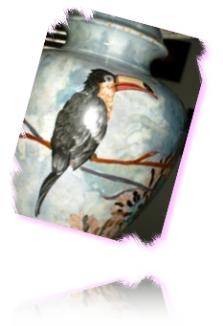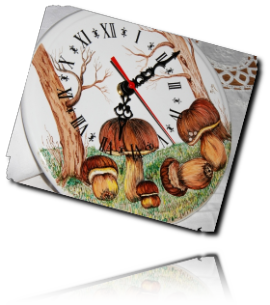Come into play
Kinds of baked clay
My works > Porcelain
Definition
I would like to share with you, in this page, the summary of a study done by my son, when he was 12 years old, about baked clay in general, because I think there are some interesting notes. If you are curious, please go on reading, otherwise skip on the following pages.
The word "Baked clay" or "Ceramic" includes each product - for different uses - that is the result of a mixture of clayey materials and water, we give any kind of shape to and that is dried or fired in stoves provided for.
Ceramic is basically a mixture of argil, a stuff that principally derives form the decomposition of the feldspathic rocks (those that compose the 60% of the earth's crust). These argils are mainly made on aluminiosilicate, with the addition of some other substances, as for potassium, sodium, calcium, barium, iron in variable quantity and composition, depending on the different places.

This rather vague term includes:
- Terra cotta: it is a moulded argil, fired in stoves, that has been utilizing since the ancient time to produce objects used in domestic life. In the Classical Period, mainly in Etruria, terra cotta was used to make sculptures and in architecture. After the Middle Ages - period when the ceramic know-how was completely lost - around the 1400, the terra cotta came into fashion again, both as sculpture material (over all under the clever hands of Della Robbia Brothers), and in architecture, composing friezes that have been resisting till the Baroque period, when they have been replaced by stuccoes.
- Majolica: It is a product having a porous mixture coated by glaze. The technique of coating the ceramic by a layer of glaze was already known by the Ancient Romans, but it has been in the Hispanic-Moorish civilization that this technique brought majolica to be as we know it now. Majolica quickly expanded in Italy during the Renaissance in the workshop situated in Fa´ence, Verona, Urbino, Castelli, Deruta, Siena, etc., laboratories that became proper schools.
- Fa´ence: This town, situated in the Region of Emilia-Romagna, during the whole Renaissance, saw developping a so important and well-known school that since that time till today the word "Fa´ence" has been meaning a refined and well decorated majolica all over the world.
- Earthenware: it is a kind of ceramic having a white and fine mixture, coated by a transparent glaze. According to the tradition, the earthenware was invented by the English John Dwight.
- Stoneware: it is a material having an opaque, dense and very hard mixture. Thanks to its peculiarities of resistance to use and to chemical agents, and thanks to its impermeability, it is employed in making tiles, over all for outdoor placing, mixing bowls to cook meals, thanks, boilers and even pipes. Stoneware is not often employed for artistic decoration, although it is easy to paint.
- Porcelain: this is a translucent, hard, not porous and kaolin-based composition. The Chinese have been exercising the monopoly over the porcelain for several centuries, till the first years of XVIIIth century, when its chemical composition was discovered in Meissen. So, porcelain immediately and speedly spread towards all the european manufatures. Porcelain is virtually chemical agents-proof and thanks to its electricity resistance it is exploited in the industry as insulating material.
- Marl: this is the material that draws the boundary line between clays and limestones. It is expecially used in building, as the base of some sort of cement.
All these materials (marls excepted) are suitable to be engraved and painted using all kinds of technique, both for industrial mass production and for artistic works made by professional or as a hobby.
